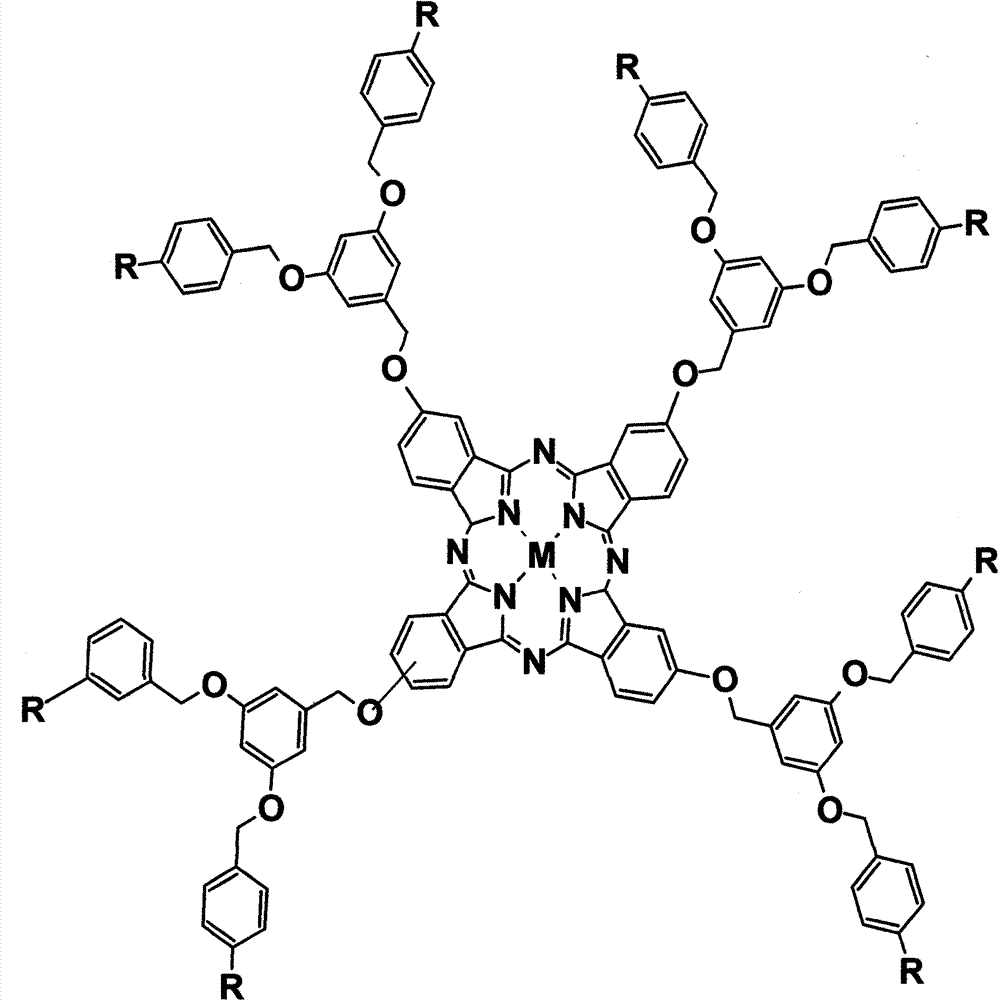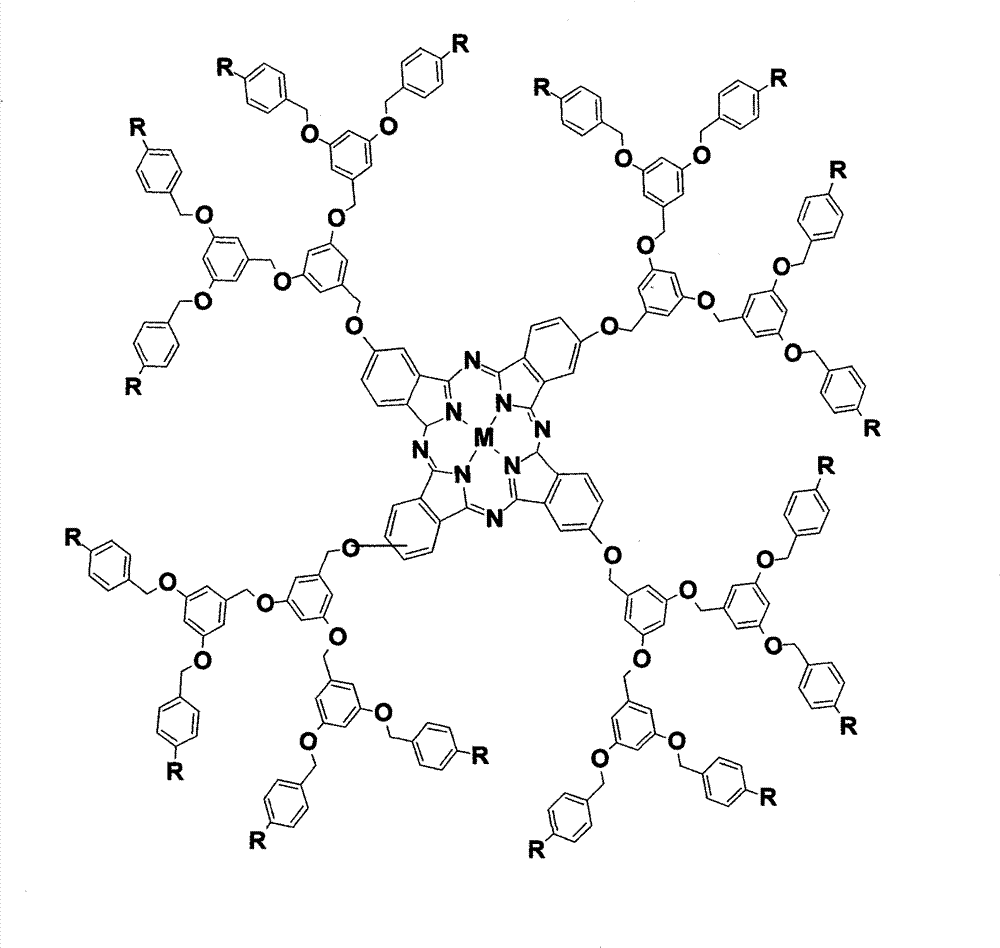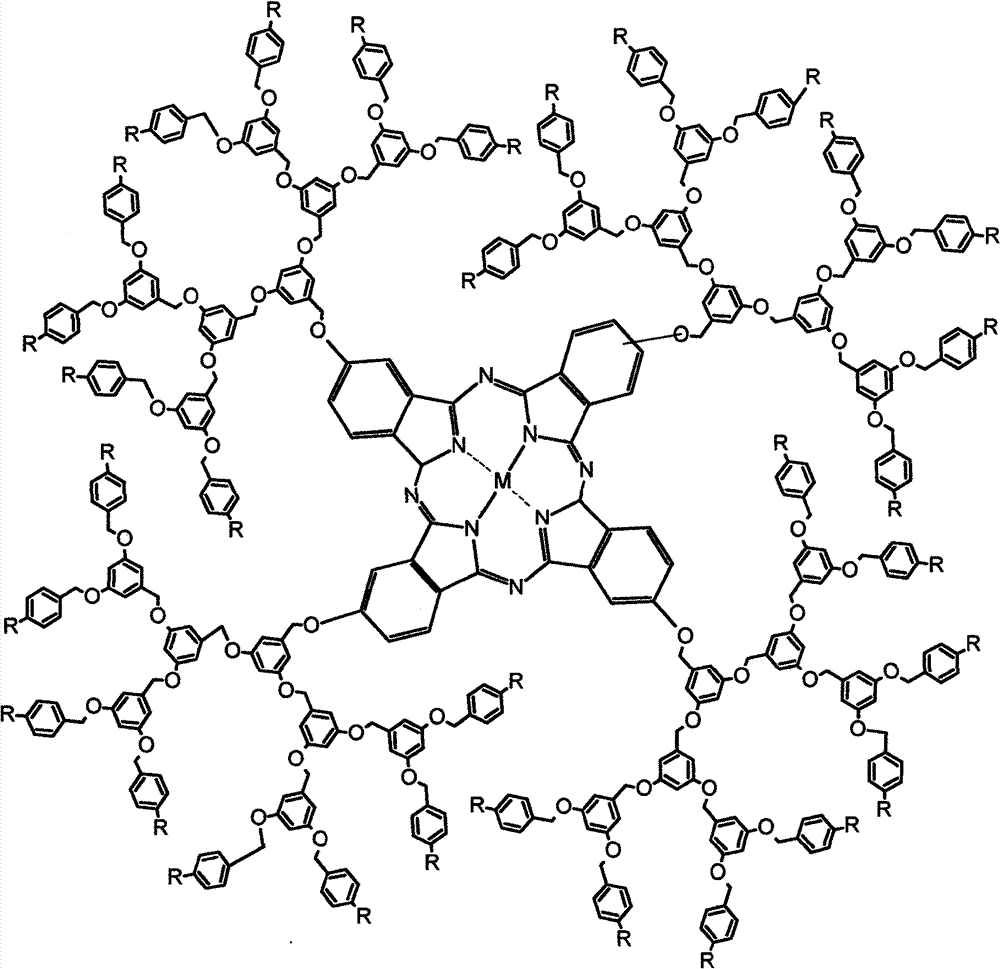1-3 generation arylene ether dendritic phthalocyanine complex and polymer nano-particle thereof
A nanoparticle and dendritic technology, which is applied in the field of 1-3 generation aryl ether dendritic zinc phthalocyanine complexes and their polymer nanoparticles and preparation fields, can solve the problems of low uptake rate and enrichment effect of new tissues.
- Summary
- Abstract
- Description
- Claims
- Application Information
AI Technical Summary
Problems solved by technology
Method used
Image
Examples
Embodiment 1
[0097] In Example 1, process 2) was changed to 8 g of carbon tetrabromide, 4 g of triphenyl phosphine and 20 mL of tetrahydrofuran, and the reaction time was changed to 2 h. Other reaction conditions were the same, and 4.0 g of white powdery solid material (2) was obtained with a yield of 65.0%.
[0098] In process 4), carbon tetrabromide was changed to 15g, triphenylphosphine was changed to 8g, and tetrahydrofuran was changed to 35mL, and the reaction time was changed to 2.5h. The other reaction conditions were the same to obtain a white powdery solid material (4) 5.04g, a yield of 80.0%.
[0099] In process 5), carbon tetrabromide was changed to 30g, triphenylphosphine was changed to 16g and tetrahydrofuran was changed to 60mL, and the reaction time was changed to 3.0h. The other reaction conditions were the same, and 5.25 g of white powdery solid substance (5) was obtained, and the yield was 82%.
specific Embodiment 3
[0100] In Example 1, the reaction temperature of process 6) was 80° C., other reaction conditions were the same, and the yield of the obtained substance (6) was 45.0%.
[0101] Process 7) The reaction temperature is 80°C, other reaction conditions are the same, and the yield of substance (7) is 30.0%.
[0102] Process 8) The reaction temperature was 80° C., other reaction conditions were the same, and the yield of substance (8) was 22.0%.
specific Embodiment 4
[0103] The synthesis method is the same as in Example 1. In the process 9)-14), aluminum trichloride is used instead of zinc acetate, and the other processes remain unchanged to obtain tetra-[3,5-bis-(4-cyanobenzyloxy)- 1-Methyleneoxyphenyl] aluminum phthalocyanine [G 1 -AlPc(CN) 8 ], the yield is 65%.IR(KBr / cm -1 ): 3449, 2921, 2231, 1601, 1452, 1168, 1059, 826, 640. 1 H NMR(400MHz, DMSO-d 6 , Δ / ppm): 7.68 (s, 4H), 7.25-7.26 (d, J=4Hz, 4H), 7.18-7.19 (d, J=4Hz, 4H) 7.66-7.68 (d, J=8Hz, 16H) , 7.46~7.48 (d, J=8Hz, 16H), 6.58 (s, 8H), 6.52 (s, 4H), 5.06 (s, 24H). MALDI-TOF-MS: m / z=2068[M+H 3 O + ]. Tetra-{3,5-bis-[3,5-bis-(4-cyanobenzyloxy)-1-methyleneoxyphenyl]-1-methyleneoxyphenyl}aluminum phthalocyanine [G 2 -AlPc(CN) 16 ], the yield is 62%. IR(KBr / cm -1 ): 3450, 2920, 2230, 1600, 1450, 1251, 1153, 1067, 822, 640. 1 H NMR(400MHz, DMSO-d 6 , Δ / ppm): 7.81~7.83(d, J=8Hz, 32H), 7.56~7.58(d, J=8Hz, 32H), 7.39(s, 4H), 7.30(s, 4H), 7.20~7.22( d, J=8Hz, 4H), 6.70 (s, 16H), 6.61 (s,...
PUM
| Property | Measurement | Unit |
|---|---|---|
| length | aaaaa | aaaaa |
| diameter | aaaaa | aaaaa |
| diameter | aaaaa | aaaaa |
Abstract
Description
Claims
Application Information
 Login to View More
Login to View More - R&D
- Intellectual Property
- Life Sciences
- Materials
- Tech Scout
- Unparalleled Data Quality
- Higher Quality Content
- 60% Fewer Hallucinations
Browse by: Latest US Patents, China's latest patents, Technical Efficacy Thesaurus, Application Domain, Technology Topic, Popular Technical Reports.
© 2025 PatSnap. All rights reserved.Legal|Privacy policy|Modern Slavery Act Transparency Statement|Sitemap|About US| Contact US: help@patsnap.com



